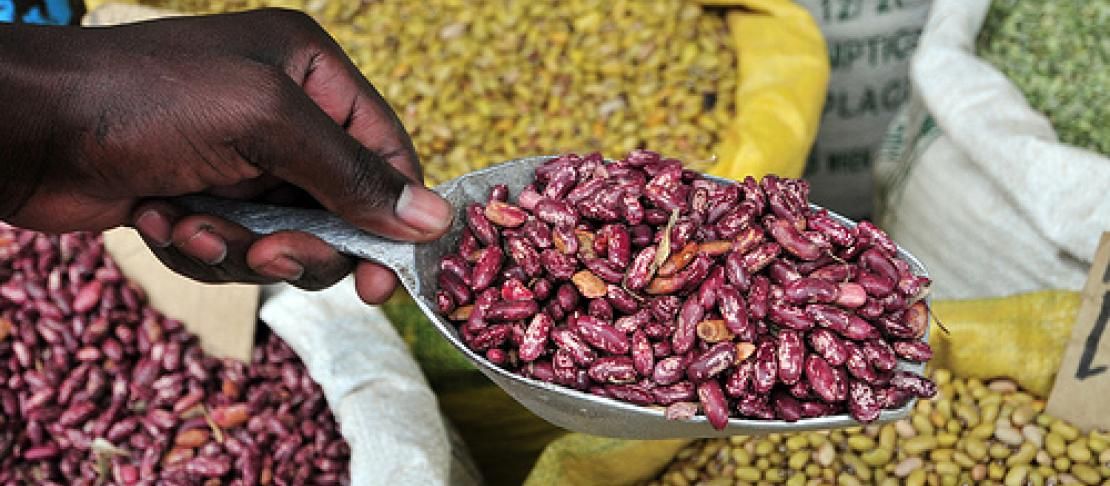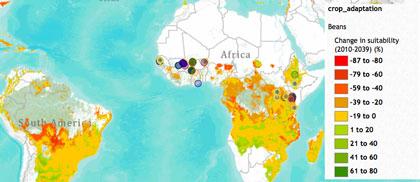Breeding climate-proof beans to protect the "Poor Man's Protein"

For most crops, "plant breeding will probably be the cornerstone" of climate change adaptation, says Stephen Beebe, a scientist from the International Center for Tropical Agriculture (CIAT) who co-authored new studies on "climate proofing" key crops across the tropics. The studies by the CGIAR Research Program on Climate Change, Agriculture and Food Security (CCAFS) highlight how climate change will impact crops that are critical to food security in the developing world, and what adaptation strategies can help reduce these impacts.
"Adjustments in crop management will also be important," says Beebe. Plant breeders like Beebe are focused on protecting beans—the so-called "poor man's protein" —which are also rich in starch, fibre, and various vitamins and minerals. Beans are essential to the food security of large areas of Africa and Latin America. But according to the new study, even the modest temperature and rainfall changes predicted for major bean-growing regions could significantly reduce the area suited for this crop.
You can now explore the data behind the studies together with photos and videos of farmers in the affected regions on the newly launched Adaptation and Mitigation Knowledge Network. This platform brings information from diverse sources onto an interactive map, to help build a rich understanding of the issues and impacts.

In Kenya, bean farmers feel the heat
In different areas of Kenya bean farmers are already feeling climate stresses. In the village of Karurumo in Kenya, Celeste Thia Kangangi and Julia Ndia have noticed changing weather patterns: "I can see the weather is changing but I cannot tell why... Now we don't get the rain cloud". The farmers, who grow beans, maize and different fruit trees, also complain about an increase in pests. Watch an interview with Celeste and Julia. In the same village, farmer R uth Marigu Njue confirms there "less rain" and that "nowadays, the beans have diseases."
uth Marigu Njue confirms there "less rain" and that "nowadays, the beans have diseases."
In nearby Kiaranga village, Emily Marigu Ireri is also suffering in a decrease in the frequency of rain and an increasing intensity of heavy rain during 3 to 4 months.
These farmers are feeling the effects of erratic rainfall and increasing pests. "Nowadays, we are still farming but we don't get big crop like we used too. Before we used to have higher yield," say Celeste and Julia. Their neighbour, Ruth, echoes their observations: "When we came to this farm, we could harvest 10 bags or 8 bags of beans. But now, I only harvest 3 or 4 bags. Now, there is less rain, they don't grow very well. I get a very poor harvest."
Says Emily in Kiaranga, "continuous rains for 3 or 4 months are not good. Beans just rot," she says. Watch an interview with Emily.
To cope with these changes, the farmers have adopted a number of strategies. In Karwe Village, in the same region, Celeste Nyaga explains how he and fellow farmers are adopting management strategies and using hybrid seed to help them to have better yield. See full video of Celeste Nyaga and his management strategies. In Karurumo, Ruth now uses fast growing and fast maturing bean varieties to take advantage of the shorter growing season. Watch an interview with Ruth.
These adaptation strategies are making a difference for the Kenyan farmers right now, but adapting to long term climatic changes will require them to adopt a new suite of actions including even newer varieties.
Bean specialists already have made significant progress in developing drought-tolerant bean varieties, which have been released in Mexico, Nicaragua, and Rwanda. In contrast, little research has been done on heat tolerance in beans, although breeders have identified both heat and drought tolerance in the tepary bean—a dietary staple in the Americas since pre-Columbian times. They believe that transferring genes for these traits into the common bean is entirely feasible. Zoom in to see current climate constraints (including heat stress) of beans in Africa.
Updated continually with new data, the Adaptation and Mitigation Knowledge Network is an initiative of CCAFS that draws on information from the CGIAR centers and partners. This story was written with contributions from Flora Mer, Osana Bonilla-Findji, and Nathan Russell (CIAT).


